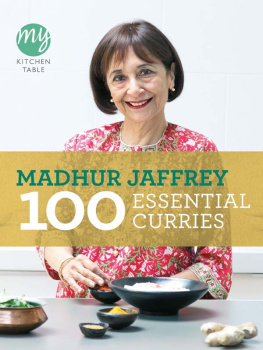THIS IS A BORZOI BOOK PUBLISHED BY ALFRED A. KNOPF
All rights reserved.
Published in the United States by Alfred A. Knopf, a division of Random House, Inc., New York, and in Canada by Random House of Canada Limited, Toronto.
www.aaknopf.com
Knopf, Borzoi Books, and the colophon are registered trademarks of Random House, Inc.
Photographs by Christopher Hirsheimer.
Illustrations by Madhur Jaffrey were originally published in An Invitation to Indian Cooking by Madhur Jaffrey, copyright 1973 by Madhur Jaffrey (New York: Alfred A. Knopf, Inc.). They appear here courtesy of Alfred A. Knopf, a division of Random House, Inc.
Introduction
T he techniques used in Indian cooking are not any different from those used the world over: roasting, grilling, steaming, frying, stewing, braising, and so on. What gives Indian cuisine its uniqueness, its tingling excitement, and its health-giving properties is the knowledgeable use of spices and seasonings, ancient in its provenance.
It is this very use of spices and seasonings that appears daunting to many approaching Indian cooking for the first time.
My purpose in writing this book is to vanquish that fear, to make Indian dishes as simple and straightforward to prepare as, say, a beef stew, and to hold your hand through the entire process with clear instructions and detailed explanations.
My own cooking has changed over the years. I am often as rushed for time as perhaps you are. I am always asking myself, Is there an easier way to do this? So, over the decades, I have simplified my cooking greatly. I now try to reach real Indian tastes by using simpler methods and fewer steps.
It is these newer recipes that you will find in this book. Just to give you an example: to make a proper curry generally calls for the browning of wet seasonings such as onion, garlic, and ginger, the browning of dry spices like cumin, chilies, and coriander, and the browning of the meat itself. Now I find that if I just marinate the meat with all the spices and seasonings and then bake it, both covered and uncovered, all the browning happens on its own; the curry absorbs the spices and is delicious.
I also searched for recipes that are simple to begin with. India has so many of those. Very often all you require is a little oil, a few whole spices, and the vegetable or fish. Saut and it is done. No fuss at all. Shrimp, potatoes, peas, they can all be cooked this way.
I have also used a smaller palette of spices. There is still a good range of them. Indian food would not be as magical without them. But these days, going out to look for spices and seasonings is no longer necessary, as all of them are offered by the Web sites of stores located in every country. Yes, your fingers can do the walking! And if you are adding one spice at a certain stage of the cooking, you can just as easily add three or four or six.
Read the recipes thoroughly before starting to cook, as sometimes an overnight marination is required. Also, it is a good idea to have all the preparations done and the spices measured out beforehand, since seasonings may need to go into the cooking pot in quick succession. Sometimes spices need to be ground. I use a coffee grinder reserved for spices, but a mortar and pestle also will do.
The recipes in this book come mainly from India but include the whole family of South Asian nations: India, Pakistan, Bangladesh, and Sri Lanka. Within these pages you will discover a from my mothers kitchen. I love them all, and you can make them with ease.
For most Indians, the center of the meal is the starch, usually rice or bread or, in some cases, both. Then there are all the things you eat with it. There is meat or fish (at banquets both may be served), one or two vegetables, some kind of dal (dried beans or split peas), some form of yogurt, a salad, and a selection of pickles and chutneys. Vegetarians would, of course, leave out the meat or fish. I have offered serving suggestions with some of the main dishes, but feel free to make your own choice. I have not always added the dals and relishes to these suggestions, but remember, they are the constants, present at most full meals. I have used the word dal frequently in this book. Even though dal is, technically, a dried split pea, the word is commonly used for all legumesdried beans and split peas. When Indians talk about having dined, they say, I have eaten my dal bhat [dal and rice] or dal roti [dal and roti]. Dal is a very important part of the meal.
You may also serve some of the dishes in this book with Western accompaniments or use these dishes as accompaniments to Western foods. For example, may be served with boiled potatoes and sauted spinach. Do what is easy and comfortable.


I ndians do not really eat an appetizer course. What happens in most homes is that an announcement is made that lunch or dinner is ready. Everyone goes first to wash their hands and then to take their places at the tableor the floor, if that is where the food is to be consumed. Most of the food appears at the same timethe meats, the vegetables, the rice or breads, the legumes, the yogurt relishes, the salads, the pickles and chutneys. At the end of the meal there is fresh fruit. For a special occasion, there may even be a dessert.



















